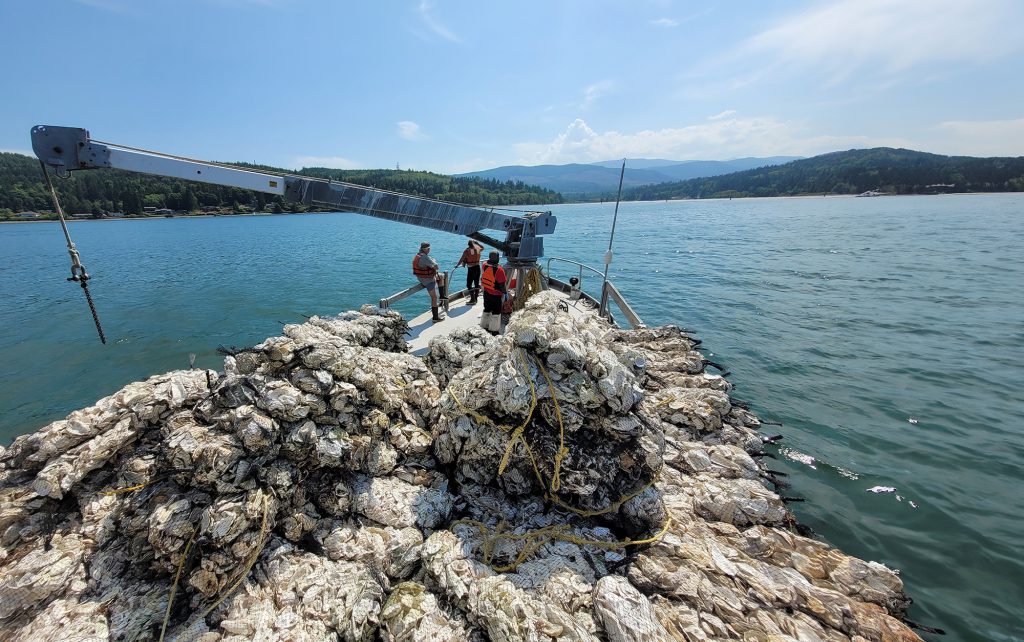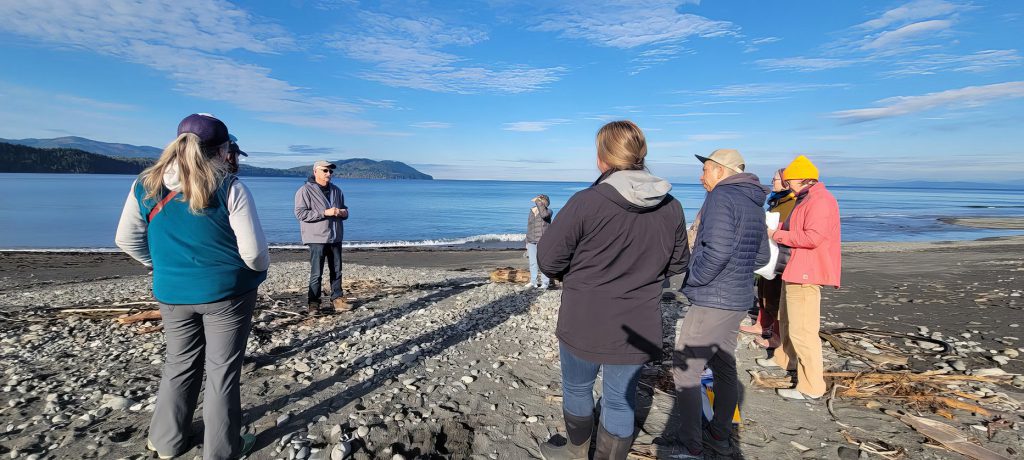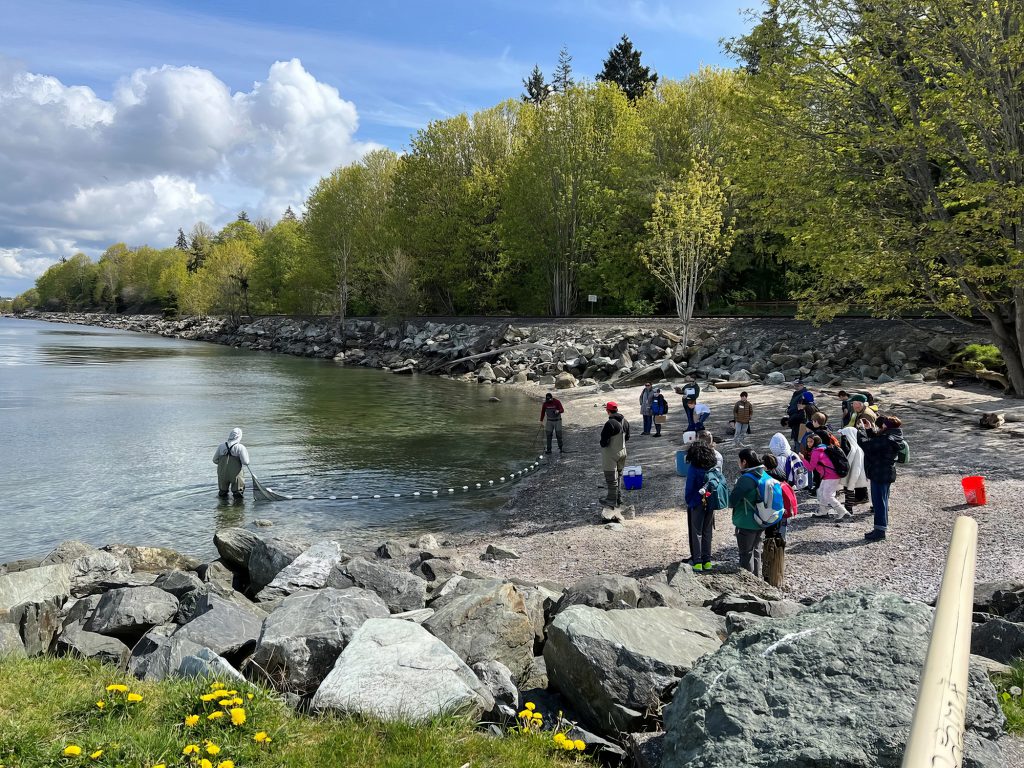
When Alan Clark joined the Northwest Straits Commission, it felt like a homecoming. An avid surfer and sailor, Clark spent most of his life on the beach and in the water, including time as a marine researcher at the University of Southern California, before moving on to become a firefighter and special education teacher. While his occupation lay elsewhere, Clark never lost his passion for the water and marine sciences.
“I felt like I was returning to my roots and adding some value to the community,” said Clark, who is now retired and represents Clallam County’s Marine Resources Committee (MRC) on the Northwest Straits Commission, and previously served as chair and vice chair. “I knew I had accomplished something when I returned home at the end of the day with either muddy waders or a wet bottom from sitting in a kayak.”
Clark is just one of the many people who have contributed to the Northwest Straits Commission’s efforts to restore and protect marine waters, habitats, and species across
northwest Washington for over 25 years. The only initiative of its kind in the United States,
the Commission provides funding, training, and support to volunteers and MRCs in
seven counties for projects such as derelict vessel removal, kelp recovery, and remote
beach cleanup.
In February, the Commission released its annual Impact Report, which celebrates
their work and achievements over the past 12 months. A quick glance through the 2023
report – the Commission’s most in-depth report yet – makes one thing abundantly
clear: the Northwest community cares deeply about its marine environment. The numbers don’t lie. For example, in 2023, over 150 volunteer hours contributed to the Jefferson MRC’s rain garden program, and more than 1,000 people engaged with Skagit MRC’s European green crab outreach and awareness project. The report is filled with stories of communities, Tribes, scientists, and organizations pulling together for the good of Puget Sound.

Northwest Straits Ecosystem Project Coordinator Alexandra Simpson helped start the European green crab project in Drayton Harbor and says the Commission’s positive reputation has made it easy to connect with communities. Some locals recognize Simpson and ask how the efforts are going. Some even thank her, although Simpson says none of it could be possible without everyone working together.
“The Impact Report is such a great reflection of different communities and organizations coming together to reach the goal of making the Salish Sea better,” said Simpson. “We’ve built multiple partnerships, and the report shows the power of communities and how the incredible work led by volunteers and a small group of staff can make a difference in the places we call home.”
“The report tells the story of many people working together to protect and restore a place they love,” said Nan McKay, the governor’s appointee to the Commission, who previously served as the Commission’s chair. “If you want to feel good, read the Impact Report.
“The Impact Report is such a great reflection of different communities and organizations coming together to reach the goal of making the Salish Sea better.”
– Alexandra Simpson, Northwest Straits Ecosystem Project Coordinator.
Lucas Hart has been the Commission’s director for six years and lauds the positive impact that volunteers have had, not just on current projects but also by helping to develop new ones. With the help of the Commission and MRCs, one person’s idea can grow into a collaboration across communities.
“Many volunteers come in with an interest, such as sea level rise, and really want to start a project, but don’t know where to start or don’t have the funding,” said Hart, who himself started as a volunteer.
“They join their MRC and suddenly they’re connected to all these people that have similar interests, and they’re connected to an organization that brings resources, such as other scientists, to the table. Suddenly, they’re leading a sea level project in their backyard.”

Community and collaboration have been the backbone of the Commission since its inception in 1998, when MRCs formed following an unpopular marine sanctuary proposal for the area. Modeled after the San Juan MRC, which formed in 1996 and consisted of a group of locally appointed citizens, the MRCs aimed to provide the local government with advice related to marine resources. They proved such a success that a blue-ribbon panel appointed by Sen. Patty Murray and Rep. Jack Metcalf recommended the model to be replicated across all seven counties in the Northwest Straits region. And thus, the Commission was born to provide the MRCs with support and services.
“It’s a bottom-up organization,” said Hart. “The MRCs submit their priorities to us, we’ll collaborate with them to build out the project when assistance is needed, and then funding to support their projects is dispersed. The MRCs do the work, we help to tell the stories so communities can learn from each other. We also look for ways to connect these great local ideas with other partners to create a multiplying effect throughout the region.
Some project highlights over the last year include the San Juan MRC’s Plastic Free Salish Sea campaign that oversaw cleanup efforts across 50 miles of county roads and beaches, and a collaboration of the seven county MRCs and Tribal partners to remove 13 derelict vessels.
“We constantly ask ourselves how we might further develop outreach strategies that are educational and engaging.”
— Barbara Bennett, Island County MRC.
One of the many highlights of the Impact Report is the continued effort between Skagit, Jefferson, Clallam, and Whatcom MRCs to restore the Olympia oyster population across seven acres of restoration sites. Over three million Olympia oyster seeds have been planted to date, a figure that makes Hart shake his head in amazement.
“It’s taken so many years to get to that point,” said Hart. “The numbers were basically zero because of our overharvest and pollution 100 years ago. Now we’re seeing the species come back thanks to this volunteer effort and collaboration with fantastic partners like Puget Sound Restoration Fund and the Jamestown S’Klallam Tribe. It’s such an awesome story.

Barbara Bennett is a member of the Island County MRC and is especially focused on
the outreach and policy elements of their work. To Bennett, because so much of Island County’s shoreline is privately owned, making communities aware of the issues they are facing and inspiring them to act begins with education.
“We constantly ask ourselves how we might further develop outreach strategies that are educational and engaging,” said Bennett. “We want to help increase understanding of marine processes, equip people to take steps to further the vitality of our marine surroundings, and cultivate the political will to support marine stewardship.”
“The report tells the story of many people working together to protect and restore a place they love.”
– Nan McKay, governor’s appointee to the Northwest Straits Commission.
The Commission’s 2023 Impact Report highlights the success of their education and outreach programs, such as Whatcom MRC’s Beach Seine with Schools, which saw 166 fourth grade students participate and learn more about juvenile salmon.
Last year, Patrick Havel joined the Island County MRC in order give back to the community through science, education, and outreach, and believes the Impact Report is an excellent source of knowledge for schools and local governments.
“It provides perspective, and is a calling card for marine stewardship,” said Havel. “It’s a
document that allows people to learn about other areas within Puget Sound that you may
not be familiar with and take note of how [MRCs are] addressing certain issues in their area.”
For Alan Clark, the report is also a good way to check in on the work of friends from other MRCs. “It’s nice to see the different MRC projects features,” said Clark. “I might possibly be inspired yet again by the commitment, expertise, and joy of service that our Commission members demonstrate.”
The Northwest Strait Commission’s 2023 Impact Report can be found on their resource library at bit.ly/2023ImpactReportNWSCommission.
Thanks to Lucas Hart, Jessica Owens, Nan McKay, Jill Lipoti, Barbara Bennet, Alan Clark,
Alexandra Simpson, Patrick Havel, and Dana Oster for their contributions to this article.

